Topaz
Common fluorosilicate belonging to the group of neosilicates ((from Greek νησος nēsos, island).
Neosilicates have isolated (insular) [SiO4]4− tetrahedra that are connected only by interstitial cations.
Source: Wikipedia
Topaz shop
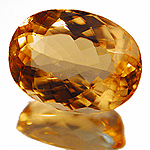
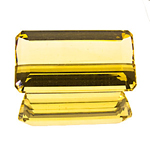
Imperial topaz and a rare yellow topaz from Ouro Preto, Brazil
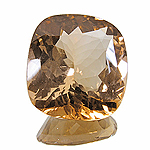
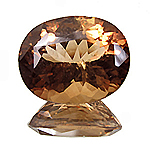
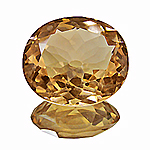
Brown topaz from Pakistan
The structural formula is Al2SiO4(F,OH)2.
The hydroxyl group OH can partially substitute for the fluorine. In the general the OH-content does not exceed 30%, although OH-dominant topaz is known. Pure OH-topaz can be produced synthetically.
The F/OH ratio greatly influences some physical and optical properties.
Pure fluor topaz is orthorhombic but with declining OH-content the symmetry diminishes to triclinic.
Refractive index as well as piezo- and pyroelectrical properties also change with growing OH-content.
Origin of name: the etymologic history of the word topaz is uncertain.
The Greek term topazos may derive from the name of an island in the Red Sea called Topazios. Most likely this was the island of Zebirget (Sebirget, Zabargad et al.). The islands name Topazios again derives from the word topazin or topazein, meaning "to seek" or "to suspect" because the island was mostly hidden by fog and thus hard to find. The Greek historian Cornelius Alexander Polyhistor (Polyhistor was born as a Roman citizen in 82 B.C., hence the latinized name) writes that stones of the colour of fresh [olive] oil were found on the island. In Volume 37 of his monumental work Naturalis Historia Pliny writes about topazos from the island in the Red Sea. In fact Zebirget the most important source of Peridot for a very long time indeed.
This assertion is all the more plausible, since up to the tenth century A.D. the word "topaz" commonly was used to describe green gemstones.
In the Septuagint, a Greek translation of the Hebrew Bible, pitdah, the Hebrew name of the second stone in the breast plate of the high priest, is given as topazos. The American mineralogist and gem collector George Frederick Kunz (in whose honour the mineral kunzite was christened) assumed the root of pitdah to lie in the Sanskrit word pita, meaning yellow, and concluded that this may indeed have meant the mineral which today is known as topaz.
The counter-argument, of course, is that in ancient times topaz denoted green gemstones.
However, other Greek scripts, e.g. of the Greek geographer, philosopher and historian Strabo, who lived around the time Christ's birth, also allude to this interpretation.
Synonyms and trade names: there are only few trade names for topaz.
Imperial topaz used to describe topaz of orangish-red colour. Today the term is widely used for orange, pink, lavender and peach colours but never for yellows and browns.
Colourless topaz, in particular from the Little Spitzkoppe Mountain in Namibia, is occasionally called silver topaz.
Frequently quartzes are marketed as topaz. The most common misnomers are golden topaz (yellow citrine), Madeira topaz (brandy coloured citrine) and smoky topaz (smoky quartz). Smoky coloured obsidian from Nevada is being sold as Nevada topaz.
This practice has some tradition and dubious legitimacy in the gem trade, but really should be discouraged as unethical.
Occasionally, however, the trade tries to ennoble topaz with names carrying more prestige. Thus blue topaz has been sold as Brazilian aquamarine, Nerchinsk aquamarine (after a Russian location) or royal aquamarine.
Oddly enough there exist some derogative trade names, as well. Yellow sapphires from Sri Lanka have been sold as Indian topaz, oriental topaz or royal topaz.
History: the history of topaz is as cloudy as the origin of its name. Its use as an ornamental stone in Egypt is documented for the period of 1580 to 1350 B.C. but in fact topaz may have been known much earlier.
Topaz and quartz are commonly associated with tin, a metal, which became highly important merchandise with the discovery of bronze, an alloy of copper and tin.
In Palestine bronze production started as early as 3300 B.C, in Egypt around 2700 B.C., in Central Europe around 2200 B.C. and in Northern Europe around 1800 B.C.
It is very unlikely that the early miners of tin ore should have missed the large crystals, so topaz could be known to mankind since four to five thousand years.
It is certain that since the time of Pliny the Elder (Gaius Plinius Secundus, 23 B.C. to Aug. 25th, 79 A.D.) the term topaz was used for green gemstones. Pliny gives its colour as leek green. Now, since green topaz is extremely rare, it is widely agreed, that from Pliny´s time to the twelfth century topaz actually meant, what today is known as peridot. Apart from describing topazos as green, Pliny also says it is soft enough to be scratched by a file and that it is found on Zebirget Island.
So the question is: what was topaz called back then?
Today with topaz one mostly associates the colours yellow, brown and light blue. Unfortunately topaz of these colours is found only in a few places on our planet. Most topaz is colourless so one can rightfully assume that it was mistaken for quartz or other colourless minerals.
In the oldest writing about gems known to us, Theophrastus' Peri Lithon ("About Stones"), mentions a stone called lyngourion. Theophrastus, student of Aristotle and his successor in the Peripatetic School, describes it as being very hard, cold and transparent. The name allegedly derives from the Italian region of Liguria, which at Theophrastus´ time comprised a much larger area than today. Indeed, there are about half dozen of small topaz localities in the (today) neighbouring Piedmont and Lombardy regions, rendering some plausibility to this theory.
Theophrastus also names the crystallos, probably meaning rock crystal. Most likely topaz was thought to be one of these two.
In his "Liber de lapidibus" (book of stones), written in the eleventh century, Marbodius, bishop of Rennes in Brittany, for the first time in history states the colour of topaz to be yellow. From that time on topaz is no longer associated with the colour green but with (golden) yellow.
In 1734 the German mineralogist and metallurgist Johann Friedrich Henckel diagnosed topaz as being different from quartz because of its different cleavage. So Henckel was the first to apply the term topaz to the fluorosilicate which bears the name today und who did not include other minerals as well.
Can be confused with: topaz can be confused with a plethora of other gems, probably easiest with aquamarine, citrine, smoky quartz, beryl, chrysoberyl and tourmaline, amongst many others.
Identification via physical and optical properties like refractive index or specific gravity is usually no big problem for the gemmologist.
Localities: common worldwide. Topaz is found on all continents. Mindat.org lists 1186 localities. The most important sources are Brazil, Sri Lanka, Russia and Nigeria.
Handling: topaz shows perfect basal cleavage which must be taken into account during cutting and setting. Do not clean ultrasonically!
It is not particularly sensitive to acids except to concentrated sulphuric acid. Galvanic baths are unproblematic.
Topaz is, however, very heat-sensitive and should be removed from the setting prior to repair jobs.
Many brown and orangish brown topazes fade on exposure to light. We once had a beautiful, intensely brandy-coloured specimen which faded to complete colourlessness within a year!
Worth knowing: topaz often is irradiated to improve or induce blue colour. Read more about irradiation treatment here.
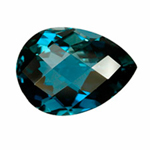
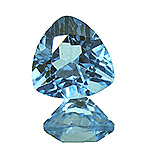
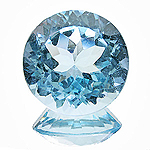
Irradtiated "London Blue", "Swiss Blue" u. "Sky Blue" topaz
Naturally blue topaz is quite rare and only in the best cases show fine aquamarine colour. It never ever sports the flashy and unnatural hue known as "Swiss blue", which is caused by irradiation. The only colour caused by irradiation which could be mistaken for a natural colour is a light blue marketed as "Sky blue".
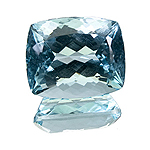
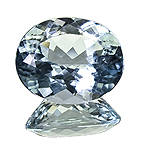
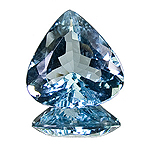
Untreated, naturally blue topaz from Brazil
Occasionally one encounters intensely green topaz on the markets. These stones owe their colour to a diffusion treatment. The coloured layer produced by this treatment usually is so thin, it can be removed by mere re-polishing. The result will be colourless topaz…
Yet another method to doctor topaz colour is by a process called CVD (chemical vapour deposition), which deposits an ultra-thin layer of metal on the stones surface, commonly titanium or gold. The colours thus produced are pink and red, green and petrol blue/green. One type of CVD treated topaz shows iridescence in all colours of the rainbow and is marketed as "Mystic Topaz". Experience shows that the coloured layer can very easily be removed be the scratch of a fingernail.
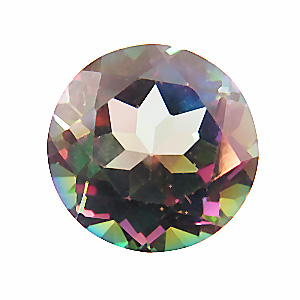
Coated "Mystic Topas"
Topaz shop
 Deutsch
Deutsch